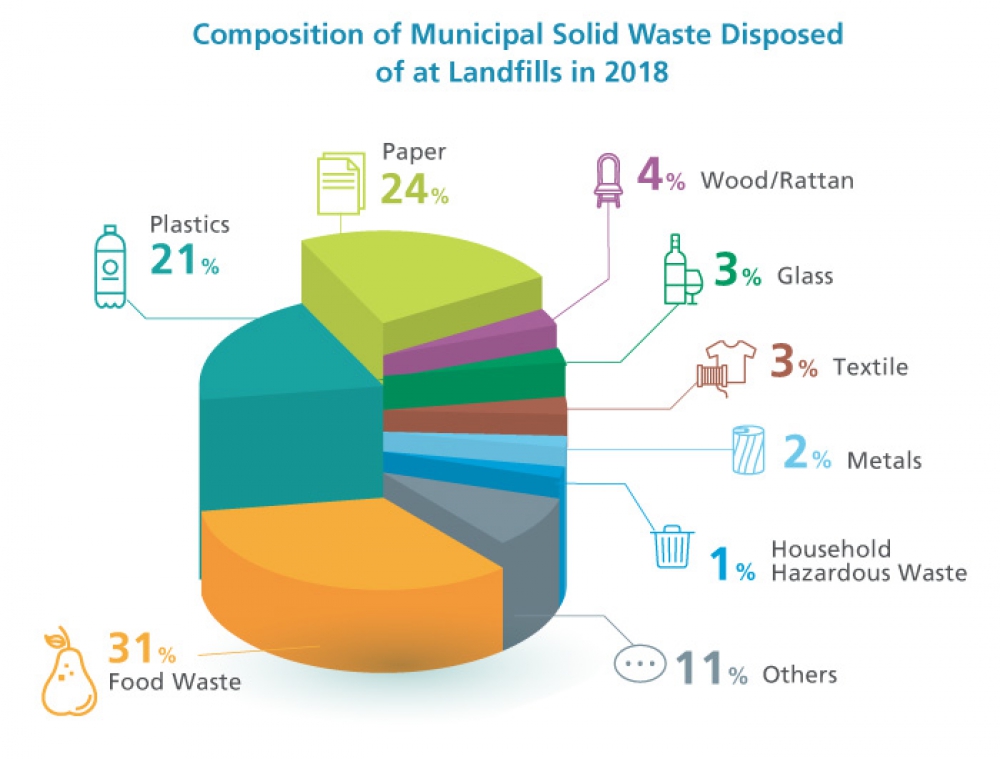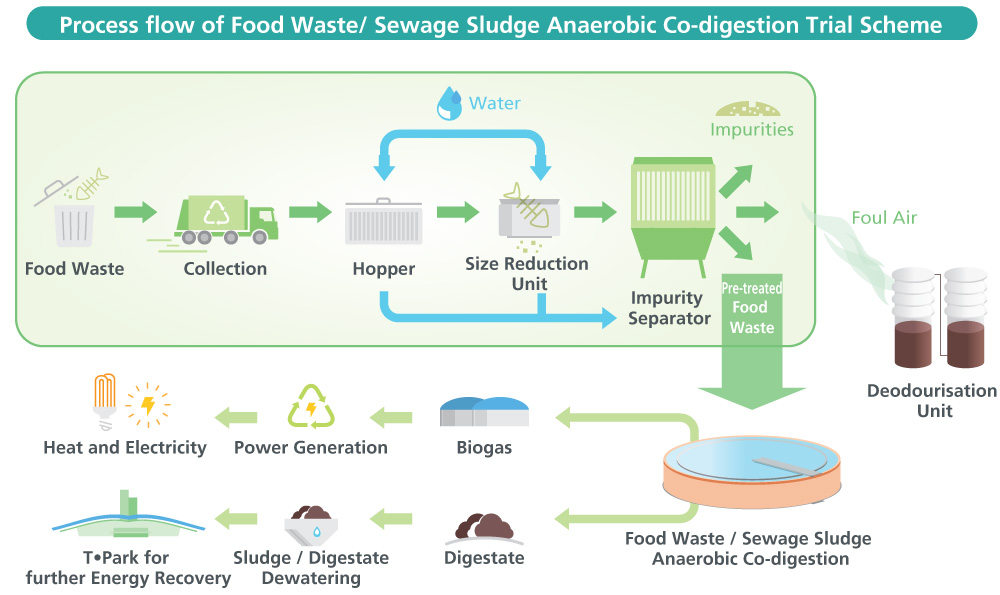Way Forward – Food Waste and Sludge Co-digestion
To harness the synergy effects of the food waste and sludge co-digestion process, DSD has as worked in close collaboration with the Environmental Protection Department (EPD) to conduct a “Food Waste/Sludge Anaerobic Co-digestion Trial Scheme” in Tai Po STW. DSD is also planning to implement similar scheme at other suitable sewage treatment works on a larger scale.
Food Waste and Sludge as Resources
Food waste is the largest component of municipal solid waste in Hong Kong. In 2018, 11,428 tonnes of municipal solid waste were disposed of at landfills each day, 3,565 tonnes of which were food waste. Sludge, a by-product of sewage treatment process is also solid waste. Currently, around 1,100 tonnes of sludge are taken to T • Park for incineration each day. On the one hand, food waste and sludge are solid waste; on the other hand, they are rich in energy resources.
Source: Hong Kong 2018 Waste Statistics – At a glance, Environmental Protection Department
Current Food Waste and Sludge Treatment Technologies
Anaerobic digestion refers to the microbiological breakdown of organic matter in the absence of oxygen. In this process, the odour and pathogens of waste and organic matter will be reduced, with biogas, a renewable energy source, generated as byproduct. Currently there are two Organic Resources Recovery Centres in Hong Kong adopted anaerobic digestion to treat food waste: Organic Resources Recovery Centre Phase 1 in Siu Ho Wan is currently in operation and Organic Resources Recovery Centre Phase 2 in Sha Ling is expected to be commissioned in 2022. These two centres are targeting 200 tonnes and 300 tonnes of food waste per day for treatment respectively and the digestate from these centres will then be further treated and turned into compost.
Currently, the sludge generated in the DSD's secondary STWs is treated in the anaerobic digesters of the plant. In the anaerobic digestion process, the volume of sludge is reduced and biogas is produced for generating electricity and heat. In some countries, digested sludge will undergo further treatment for use as compost, while in Hong Kong the digested sludge is dewatered and then transported to T • Park for use as fuel in the incineration process, realising the concept of waste-of-energy. Heat produced from the incineration process is recovered and converted into electricity.
Anaerobic Co-digestion
Anaerobic co-digestion of food waste with sludge, hereinafter referred to as co-digestion, has been successfully applied overseas. Compared with anaerobic mono-digestion of food waste and sludge, co-digestion reduced solids content and increases the production of biogas, which can be used to generate energy and supplement the STWs' energy consumption. With sufficient food waste and sludge, co-digestion has the potential to produce sufficient biogas to meet the energy demand of STWs. The Government is exploring the use of co-digestion in existing STWs to extend the network of organic resources recovery facilities, hence raising Hong Kong's food waste treatment capacity.
50-tonne Co-digestion Trial Scheme at Tai Po Sewage Treatment Works
The 2016 Policy Address announced that a co-digestion trial scheme will be conducted at Tai Po STW from 2019 onwards, treating 50 tonnes of food waste and sludge everyday. The trial scheme includes the construction of a food waste pre-treatment plant with a treatment capacity of 50 tonnes, located at the Shuen Wan Leachate Pre-treatment Works, adjacent to Tai Po STW and an operation trial scheme. The co-digestion trial scheme is collaboratively run by the DSD and EPD.
Under the trial scheme, EPD's engineering works include construction of a food waste pre-treatment plant. Here, food waste is pre-treated to remove impurities before being mashed and turned into food pulp. DSD's engineering works include modification of a digester designated to receive food waste. The modification works include replacement of the sludge mixer in the digester with a new mixer that is suitable for blending the sludge and food waste, which have a higher solids content, homogeneously. The trial scheme started in September 2019. During operation, EPD is responsible for collecting, delivering, pre-treating and pumping food waste to the designated anaerobic digester at Tai Po STW, while DSD is responsible for the operation of the digester and utilisation of biogas to generate heat and electricity for STWs' use.
Benefits of 50-tonne Co-digestion Pilot Trial Scheme at Tai Po Sewage Treatment Works
DSD's modification works for the designated digester under the trial scheme took only 12 months. With the food waste pre-treatment plant and STWs adjacent to each other, the trial scheme attains the benefits of co-location and co-treatment. Whether microorganisms in the digester can effectively degrade organic solids, depends on the nutrient balance in the digester. Compared with mono-digestion, co-digestion can enhance the degradation efficiency, hence decreasing solids content and boosting biogas yield. In Hong Kong, digested sludge will be dewatered and transported to T • Park to be used as fuel in the incineration process. Heat generated during the process will be recovered and converted into electricity. In this process, the dewatered digestate will become ash, meaning it volume will decrease by 90%. Consequently, precious landfill space can be saved.
Installation of new mixer inside the sludge digester designated for food waste and sludge co-digestion at Tai Po Sewage Treatment Works




